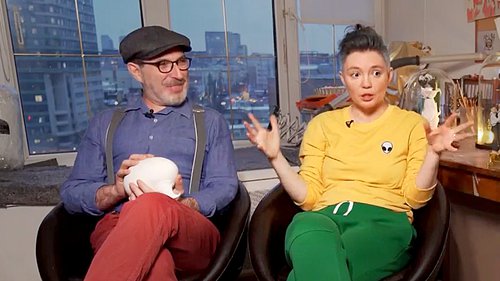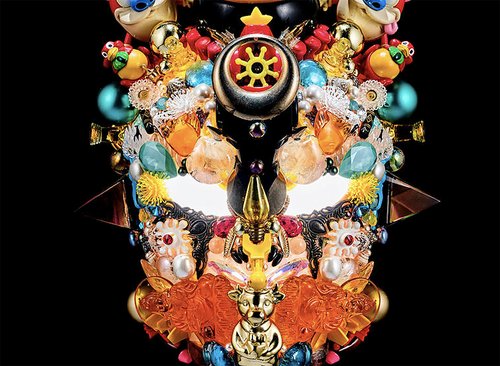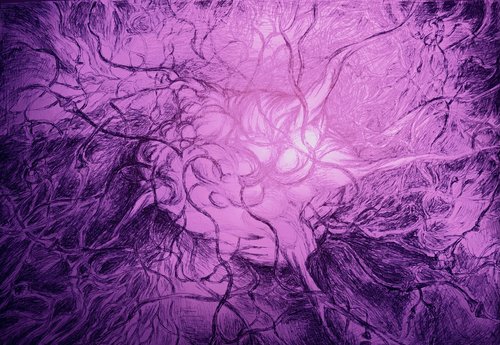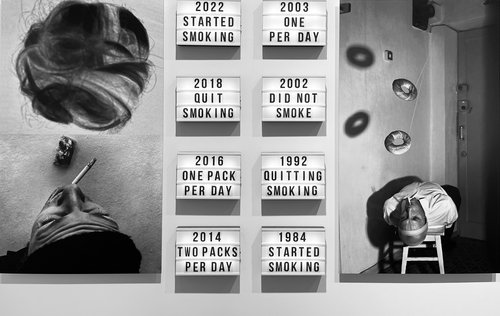MishMash Artist Duo: Ugliness is Beauty

MishMash. The Future of the Past. Exhibition view. Berlin, 2025. XL Projects Berlin. Courtesy of the artists
This Moscow-born art collective now residing in Berlin is living up to its name, rethinking chaos as the new Baroque.
Misha Leykin (b. 1968) and Masha Sumnina (b. 1977) aka MishMash like to avoid any clear definitions or specific places as through their art they explore an exceptionally broad spectrum of practices, methods and media. They simply refuse to be put into any box. Misha and Masha’s first collaboration project was shown in 2000 at the Defile exhibition at L Gallery in Moscow consisting of a see-through dress with things tucked inside it. This historical work has been partly recreated within their latest exhibition hauntologically called ‘The Future of the Past’.
Soon after they emerged onto the art scene the duo emigrated to the USA, where they became MishMash, both a fusion of their first names as well as an allusion to their poetics. It was in New York that some of the collective´s most important tropes were born, including their interest in public art and interaction with broader audiences. Beggar Robot (2001-2004) together with Jake Klotz (b. 1966) was a mechanical one-handed device on wheels which resembled an outdated vacuum cleaner and was capable of performing simple actions including begging, talking and listening patiently. It was at the core of several performances, where their goal was to provoke public reactions. Another notable project was Shrink (2002), consisting of series of photos of Masha on a tiny scale in different daily situations, as if she were in the land of giants. It was also a comment on her mental state, as at that time she was seeing a therapist (or shrink!).
We see the use of self-reference as a medium, where they put their own personas into bodies of their work in ‘SuperJew’ (1997 – ongoing) where Misha Leykin dressed up as a useless superhero whose only power is being the Other, or in ‘Modulor on Vacation’ (2016), a series of photos with Masha’s cardboard cutout figure as an omni-present unit of measure. Later, ‘MishMash – Artist of the Year’ which won special project of the year at Cosmoscow in 2019, referred to some of their earlier projects and here they also used Modulor and SuperJew figures, placing them around the venue in small-scale interventions in peripheral areas or in-between zones at the fair.
When they left New York and returned to Moscow several years later, MishMash group developed more lines of artistic inquiry. A recurring interest is sign systems made out of elements taken from everyday observations such as the series ‘Geopsychoisometrical Examination of the City 1-4’ (2011–2016), where they used the help of local respondents who photographed their home cities in search for visual idioms of everyday routines in Ekaterinburg, Moscow, Pervouralsk and Vyksa. The artists then took these elements and produced series of paintings that bordered on abstraction, but were in fact quite realistic, depicting places as if seen through the perspective of an alien.
They are also interested in collections and collecting, another meta-project in their work. These can be objects, recurring experiences, charts or actions. In 2014 MishMash showed the ‘Spa-Theater of Ageing’ at the XL Gallery in Moscow, twelve huge wall-size scrolls with daily weather charts, filled with “statistics of our inner physical and metaphysical parameters in connection with the incoming impact from the outer world”, as the group describes it.
Such practices connected with leaving a daily trace or mark have a long history in conceptual art, such as On Kawara (1932–2014) and Tehching Hsieh (b. 1950), but MishMash bring a warm and fuzzy vibe. Often, it is a self-curing practice in situations of experienced pressure. Examples are The Hours (2020) and Compulsive Countdown (2020), series of watercolours done during the lockdown.
Finally, but no less significant for MishMash is their interest in obscene objects. Rocks are a long-term fascination for them, in Real Estate (2010) there are stones in knitted hats hanging within individual boxes like lamps along staircases. The boxes are painted in the kind of pastel colours used in Russia by communal service providers and mounted in an installation stuffed with old newspapers to avoid any drafts. Wrap things up, make them cosy and comfortable!
This may be rooted in Dada practices and attitudes but evolves along a different line as the group looks to re-define the notion of beautiful. MishMash have even invented a word of their own: Hideoism, which comes from ‘hideous’. On their site, MishMash comments: “Hideoism finds pleasure, delight and beauty in the casual, absurd and disgusting. Hideoism is partnering with chaos, confusion, style of janitors, madmen and Scotch tape. There is an internal logic and a practical ground in Hideoism, but somewhere in the middle of the road they turn into the force of nature.”
In ‘Construction Set for David Hume’ (2021) there were twenty-five dadaist assemblages made from strange materials. Shown at the exhibition ‘Assuming Distance: Speculations, Fakes, and Predictions in the Age of the Coronacene’ at the Garage Museum in Moscow, it became a forest with individual works under glass covers mounted on tree-like structures at face height, calling for an explanation – which is not given.
This search for the hideously beautiful has drawn MishMash’s attention to the baroque as a universal language: “In the baroque, folds are key. And the contrast between light and shadow, the opposition of black and white, are born from the folds of the same fabric.” And of course, for them there is no impasse between the languages of art in different time periods: “It is possible that Joseph Kosuth realized the triple identity of his chair when he visited the Villa Borghese; at least, we had an epiphany there, looking at the ceiling, where several worlds are intertwined – three-dimensional sculptures, two-dimensional paintings of sculptures and painting per se; the next layer could well be today’s augmented reality.”
The baroque can be seen in several of their most recent exhibitions. Their current show at XL Projects Berlin curated by Elena Selina is a cheerful end of the world. It consists of two walls marking space that is normally used as a workshop. The walls show an inverted horizon with tree branches above the line representing nature that does not care for us at all, and below it, characteristic assemblages made of all kinds of debris that somehow are recognizable as column volutes and stucco molding. “We made … these baroque vignettes out of all kinds of crap—bones, chewing gum, plaster bandages, cotton wool—but here's the paradox: when you reproduce reality or ideas about reality in art, it inevitably shifts from the category of the hideous to the category of the beautiful. That's why we humans revel in our ideas, even if they are inconsistent, but we simply like the fact that we have brought elements together and they somehow hold together.”
In fact, it works together like a stage set in the theatre: fake clouds of gauze overhead, gaps between walls that do not hide equipment and construction materials. The opening of the exhibition included an audio performance by Lisokot, who has composed an epigram (baroque musically and textually) in homage of the echinus – an architectural element inspired by the sea urchin, and he performed it within the set.
In the middle there is a big black ball hanging from the ceiling that resembles an asteroid that is going to smash the world out of existence and its diminutive counterpart is a small object where two walls converge which could be a black hole. Together these two things form an axis of tension which creates a weird feeling like the one after Lars von Trier’s ‘Melancholy’, only lighter.
The Future of the Past
XL Projects Berlin (Open by appointment, contact: XLProjectsBerlin@gmail.com)
Berlin, Germany
29 April – 10 June 2025






















